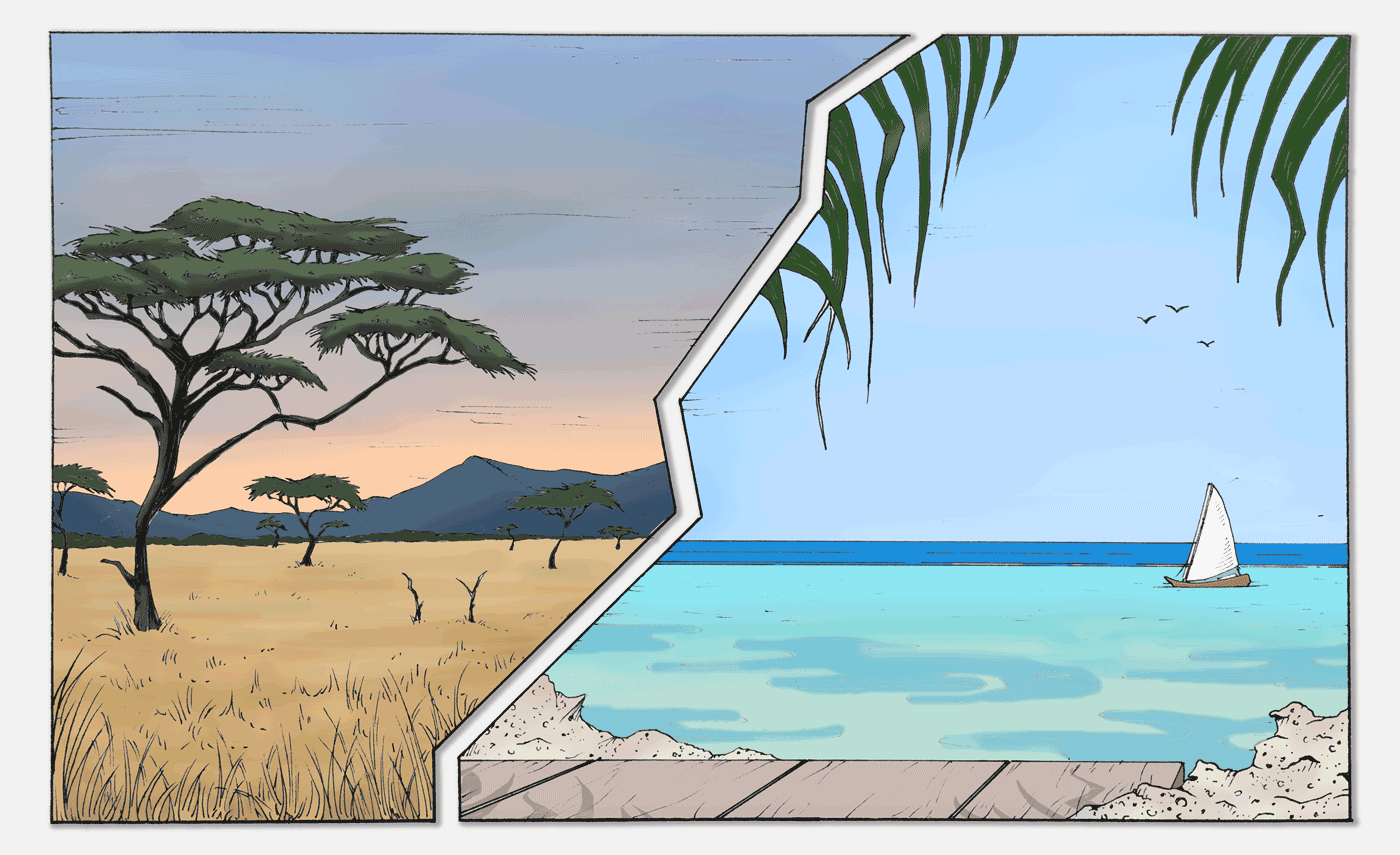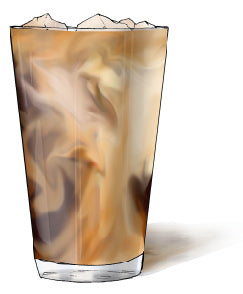
ICED COFFEE VS COLD BREW
Zanzibar: a coastal jewel of East Africa, bright and enlivening with sunset views showing all the glistening colors of coral that lounge beneath the ocean surface. Just east of it: the Serengeti, full of wildlife and covered in an expanse of soil and tall grass, elevated by a rolling terrain that evokes the most invigorating sights in “The Lion King.”
Two very different landscapes, yet bonded by their proximity. Consider that your starting point for understanding the differences between cold brew and iced coffee – neighbors who have a lot in common, but some very core differences of note.
Why? That’s easy: You don’t really need milk to enhance its flavor – or much ice, for that matter.
Two very different landscapes, yet bonded by their proximity. Consider that your starting point for understanding the differences between cold brew and iced coffee – neighbors who have a lot in common, but some very core differences of note.
Why? That’s easy: You don’t really need milk to enhance its flavor – or much ice, for that matter.
What is iced coffee?
So, getting to the basics: What’s considered “iced coffee”?To keep it simple: It’s coffee poured over ice.
But the devil really is in the details, here. Iced coffee is often prepared (and best prepared) in a Japanese “flash brew” manner – that is, brewed hot and immediately put in contact with ice, to cool it down. A few things happen during this process that make it more appealing than just dumping the coffee into a glass of ice, but what you need to know is that coffee is very sensitive to temperature and cooling it immediately – rather than waiting – will keep it on life support. You won’t lose all the flavors that heat naturally extracts better than cold water (it’s a particularly boring chemical process with caffeine – just take our word for it) and, in a practical sense, the beverage is served cold and smacks your taste buds faster this way. By the time you pick your cup from the cabinet, you’ll see you barely need ice; thus, you’re not diluting your drink as much.
Iced coffees are also seldom served as dark roasts, as you’ll end up with bitter flavor notes that, truthfully, aren’t all that appetizing on ice. Light and fruity roasts are your friend here, ground a little finer than ones used for cold brew.
Cold brew coffee boasts a consistency that coffee poured over ice does not. Because it’s steeped for such a long period of time (up to 24 hours), its flavor is defined by coarse grinds’ exposure to cold water and the length of exposure, more so than the blend of the coffee itself. (Note: No, that doesn’t mean you should use low-quality grinds – but maybe repurpose some leftover coffee that has an older roasting date.) As a result, your coffee will almost always boast variations of a chocolate-caramel quality, defined by its smooth texture and heavier punch than standard iced coffee – made better by the fact that it’s brewed cold, so melted ice won’t dilute your coffee. That’s also a big part of why you might feel a heavier caffeine punch.
What is cold brew?
You can read all about cold brew (and learn how to make it) through our cold brew guide, but the key differences are the coffee’s exposure to cold water -- as well as how long that coffee is exposed. Think of it like slow-cooking your food: Yeah, it’ll take longer, but you get a completely different experience with the same food that might otherwise be baked or sautéed.Cold brew coffees are easy to identify even without a label: You’ll taste flavor notes that are naturally sweet and chocolaty and feel a full-bodied texture swirling around in your mouth. Because you’re skipping the interaction with hot water – which will draw more of the acidity out of your coffee grounds – the cold brew will never turn up the bitterness of a hot brew. The trade-off is you’ll often have similar-tasting flavor notes no matter what coffee you use (with exceptions, obviously), and will need to expose the coffee to cold water for a longer period of time just for the water to extract flavor from the coffee. Cold brew can take as long as 24 hours to properly brew.
On the other hand, cold brew will keep longer than standard iced coffee – sometimes lasting for weeks, as opposed to a single day. Which leads us into the next question: Is there a “superior” version of iced coffee?
Take a world tour of amazing coffee

Take a world tour of amazing coffee
- Coffee you can’t find on the shelves
- Roasted fresh & delivered to you
- Tailored to your preferences
- All for under $.30 a cup

IS ONE BETTER THAN THE OTHER?
No, not necessarily. And just like with a coffee roast, it’s likely going to depend on taste preference.You will, without question, enjoy a cold brew more if you’re looking for a sweeter coffee or trying to avoid putting milks and sugars in your coffee to make it sweet. You may also prefer the longer shelf life, its flexibility with added ingredients (see our recommendations), plus its low acidity levels.
On the flipside, iced coffee is not inherently worse – not by any stretch. In fact, if you’re looking for a more complicated-tasting coffee, you’ll prefer an iced coffee over a cold brew. Why? Because just like with a hot cup of coffee, you’re able to extract more of the coffee’s latent flavor notes when using the ideal temperature of approximately 200 degrees Fahrenheit. You may find that the same fruity coffee transports you to a sunny, oceanside garden patch in Zanzibar with iced coffee, as opposed to the grassy plains of the Serengeti.
HOW TO MAKE ICED COFFEE:
For as complex as “Japanese flash brew” may sound, it’s actually a pretty simple process for at-home brewing. Here’s how to make it:
WHAT YOU'LL NEED
- Pourover brewer
- Grinder
- Kettle
- Scale
- Filter
- Ice
Iced Coffee - Instructions
- Measure out coffee and water. Water-to-coffee ratios vary depending on preference, but aim for about a 12:1 ratio, with about one-third of the water measurement accounted for as ice. Measure out the ice last by putting it in a cup (also accounting for the weight of the cup).
- Grind the coffee on a fine setting, to taste
- Wet the coffee filter. Place cubes of ice into receptacle, then dump the grounds into the filter.
- Heat the water to approximately 195 to 203 degrees Fahrenheit. Let sit for 30 seconds before beginning to pour – slow at first, before leveling off at a steady speed, sure to cover all of the grounds.
- After pouring for about three minutes, ice should be completely melted and blended into coffee. Pour the coffee over your desired amount of ice and enjoy!
Three tips to spruce up your iced coffee:
- Add coffee iced cubes. How? Simple: Make more iced coffee during the brewing process – assuming you’ll be refrigerating the coffee and saving some for later – and place them in the freezer until frozen.
- Make more cubes ... of creamer. An easy way to keep your coffee as concentrated as possible is to throw in a few cubes of frozen creamer. It’s less water, and the same amount of creamer you’d be adding anyway.
- Experiment. Just like with hot coffee, the easiest way to improve your experience is to tinker with grind sizes and roasts. If the finer grind is tasting a little too bright and light-bodied for your taste, adjust the grinder to a medium size.
For a limited time - Take 50% off of your first shipment of amazing single origin, specialty grade coffee from around the world.